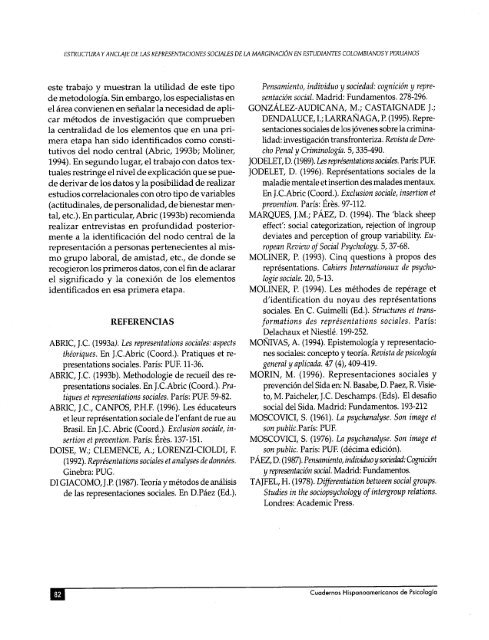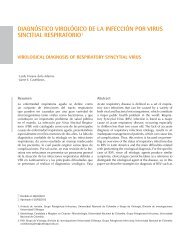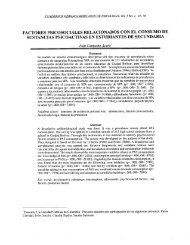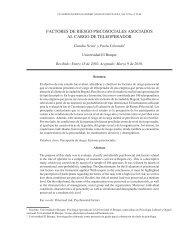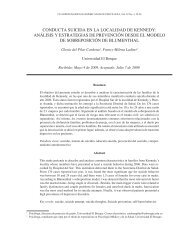Estructura y anclaje de las representaciones sociales de
Estructura y anclaje de las representaciones sociales de
Estructura y anclaje de las representaciones sociales de
You also want an ePaper? Increase the reach of your titles
YUMPU automatically turns print PDFs into web optimized ePapers that Google loves.
este trabajo y muestran la utilidad <strong>de</strong> este tipo<strong>de</strong> metodologfa. Sin embargo, los especialistas enel area convienen en sefialar la necesidad <strong>de</strong> aplicarmetodos <strong>de</strong> investigaci6n que compruebenla centralidad <strong>de</strong> los elementos que en una primeraetapa han sido i<strong>de</strong>ntificados como constitutivos<strong>de</strong>l nodo central (Abric, 1993b; Moliner,1994). En segundo lugar, el trabajo con datos textualesrestringe el nivel <strong>de</strong> explicaci6n que se pue<strong>de</strong><strong>de</strong>rivar <strong>de</strong> los datos y la posibilidad <strong>de</strong> realizarestudios correlacionales con otro tipo <strong>de</strong> variables(actitudinales, <strong>de</strong> personalidad, <strong>de</strong> bienestar mental,etc.). En particular, Abric (1993b) recomiendarealizar entrevistas en profundidad posteriormentea la i<strong>de</strong>ntificaci6n <strong>de</strong>l nodo central <strong>de</strong> larepresentaci6n a personas pertenecientes al mismogrupo laboral, <strong>de</strong> amistad, etc., <strong>de</strong> don<strong>de</strong> serecogieron los primeros datos, con el fin <strong>de</strong> aclararel significado y la conexi6n <strong>de</strong> los elementosi<strong>de</strong>ntificados en esa primera etapa.ABRIC, J.e. (1993a). Les representations <strong>sociales</strong>: aspectstheoriques. En J.e.Abric (Coord.). Pratiques et representations<strong>sociales</strong>. Paris: PUE 11-36.ABRIC, J.e. (1993b). Methodologie <strong>de</strong> recueil <strong>de</strong>s representations<strong>sociales</strong>. En J.e.Abric (Coord.). Pratiqueset representations <strong>sociales</strong>. Paris: PUE 59-82.ABRIC, J.e., CANPOS, P.H.E (1996). Les educateurset leur representation sociale <strong>de</strong> l'enfant <strong>de</strong> rue auBrasil. En J.e. Abric (Coord.). Exclusion sociale, insertionet prevention. Paris: Eres. 137-151.DOISE, w.; CLEMENCE, A.; LORENZI-CIOLDI, E(1992). Representations <strong>sociales</strong> et analyses <strong>de</strong> donnees.Ginebra: PUG.DI GIACOMO, J.P.(1987).Teoria y metodos <strong>de</strong> amilisis<strong>de</strong> <strong>las</strong> <strong>representaciones</strong> <strong>sociales</strong>. En D.paez (Ed.).Pensamiento, individuo y sociedad: cognici6n y representaci6nsocial. Madrid: Fundamentos. 278-296.GONZALEZ-AUDICANA, M.; CASTAIGNADE J.;DENDALUCE, I.; LARRANAGA, P. (1995).Representaciones<strong>sociales</strong> <strong>de</strong> los j6venes sobre la criminalidad:investigaci6n transfronteriza. Revista <strong>de</strong> DerechoPenal y Criminologia. 5, 335-490.JODELET,D. (1989).Les representations <strong>sociales</strong>. Paris: PUEJODELET, D. (1996). Representations <strong>sociales</strong> <strong>de</strong> lamala die mentale et insertion <strong>de</strong>s mala<strong>de</strong>s mentaux.EnJ.e.Abric (Coord.). Exclusion sociale, insertion etprevention. Paris: Eres. 97-112.MARQUES, J.M.; pAEZ, D. (1994). The 'black sheepeffect': social categorization, rejection of ingroup<strong>de</strong>viates and perception of group variability. EuropeanReview of Social Psychology. 5,37-68.MOllNER, P. (1993). Cinq questions a propos <strong>de</strong>srepresentations. Cahiers Internationaux <strong>de</strong> psychologiesociale. 20, 5-13.MOllNER, P. (1994). Les metho<strong>de</strong>s <strong>de</strong> reperage etd'i<strong>de</strong>ntification du noyau <strong>de</strong>s representations<strong>sociales</strong>. En e. Guimelli (Ed.). Structures et transformations<strong>de</strong>s representations <strong>sociales</strong>. Paris:Delachaux et Niestle. 199-252.MONIVAS, A. (1994). Epistemologfa y <strong>representaciones</strong><strong>sociales</strong>: concepto y teoria. Revista <strong>de</strong> psicologiageneral yaplicada. 47 (4), 409-419.MORIN, M. (1996). Representaciones <strong>sociales</strong> yprevenci6n <strong>de</strong>l Sida en: N. Basabe, D. Paez, R. Visieto,M. Paicheler, J.e. Deschamps. (Eds). El <strong>de</strong>safiosocial <strong>de</strong>l Sida. Madrid: Fundamentos. 193-212MOSCOVICI, S. (1961). La psychanalyse. Son image etson public. Paris: PUEMOSCOVICI, S. (1976). La psychanalyse. Son image etson public. Paris: PUE (<strong>de</strong>cima edici6n).PAEZ,D. (1987).Pensamiento, individuo y sociedad:Cognici6ny representaci6n social. Madrid: Fundamentos.TAJFEL, H. (1978). Differentiation between social groups.Studies in the sociopsychology of intergroup relations.Londres: Aca<strong>de</strong>mic Press.


